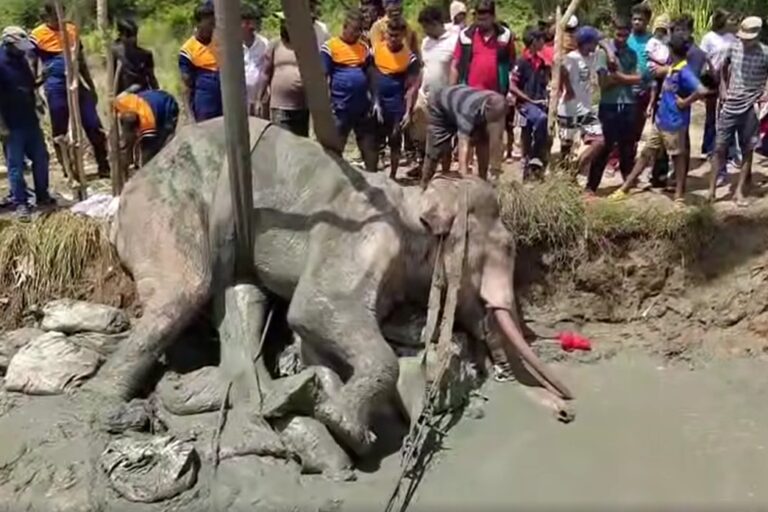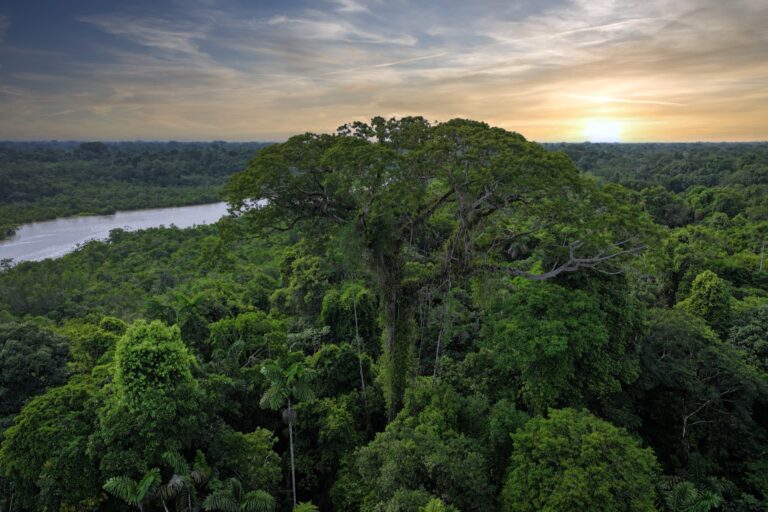Founder’s Briefs: An occasional series where Mongabay founder Rhett Ayers Butler shares analysis, perspectives and story summaries.
In the Peruvian Amazon, a series of curious encounters has left biologists scratching their heads.
Camera traps have captured an unexpected partnership: solitary, nocturnal ocelots (Leopardus pardalis) strolling alongside common opossums (Didelphis marsupialis). Not once, but four times, in distinct locations over several years, the feline predator and its potential prey were seen moving together—sometimes even returning along the same path minutes later, still in tandem. The opossum, far from appearing alarmed, showed no signs of distress.
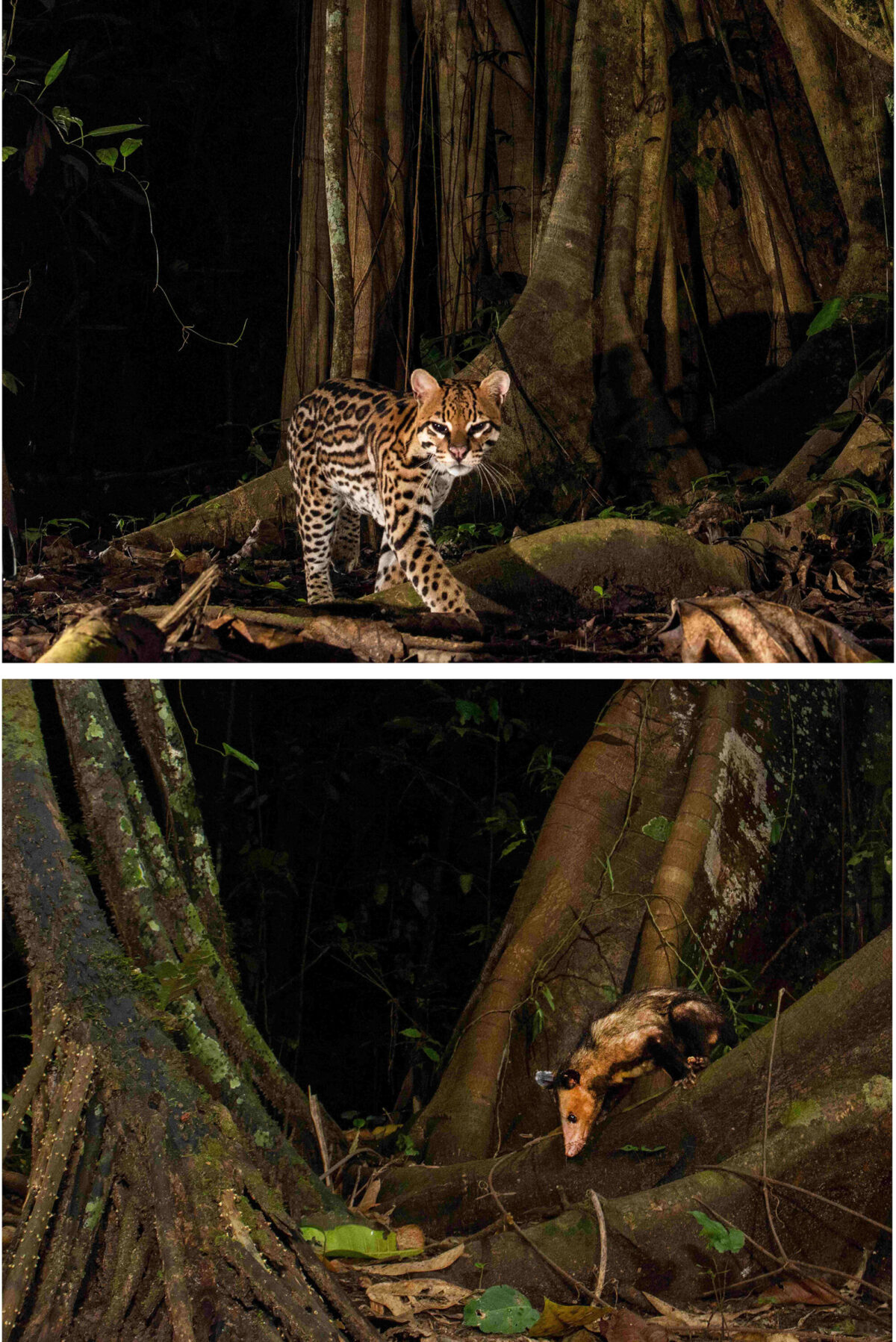
This behavior is not only puzzling; it is without precedent. Associations between solitary carnivores and omnivores—especially those that occasionally dine on one another—are vanishingly rare. Yet further evidence suggests this pairing is more than happenstance. In field experiments, opossums showed a distinct preference for the scent of ocelots over that of pumas or neutral controls. They lingered, sniffed, and rubbed themselves against the ocelot-scented fabrics, as though seeking some form of chemical communion.
Why cozy up to a cat that might eat you? The researchers, writing in the journal Ecosphere, suggest two possibilities: improved foraging efficiency or olfactory camouflage. Opossums may benefit from the ocelot’s hunting prowess, while the ocelot may gain from masking its scent with the opossum’s pungency. There is precedent in the animal kingdom: coyotes and badgers have been known to hunt cooperatively, trumpetfish hide behind larger fish to ambush prey, and some marsupials resist snake venom—knowledge the ocelot may intuitively exploit.
“Opossums have a strong smell, and a close-by ocelot might help hide the opossum’s scent from bigger predators, or the opossum’s odor might mask the ocelot’s presence from prey,” Ettore Camerlenghi, an ecologist at ETH Zurich and the lead author of the study, told the New York Times.
Whether this is mutualism, manipulation, or mere curiosity remains unknown. But the discovery is a reminder of how little is understood about rainforest dynamics. Even in well-trodden ecosystems, the wild has secrets yet to reveal—one cautious step at a time.

In Bangladesh, disposable tableware, including plates made of areca palm leaves, is gaining popularity as a good alternative to single-use plastic during social gatherings and festival celebrations, Mongabay’s Abu Siddique reported in May.
A survey from 2018 estimates that Bangladesh used around 250 metric tons of single-use plastic tableware and straws every month. However, since the first areca palm leaf tableware producer, Bright Areca, set up business in the country in 2017, the industry has grown to about 10 local companies producing biodegradable tableware.
The industry is fairly new, though, and areca palm leaf plates are still far from fully replacing single-use plastic ones.
Imran Hossain, a partner of Bright Areca, the largest company in the space, told Siddique he estimates the industry produces around 500,000 plates a month. “My company produces about 100,000 plates in a month based on demand,” he said.
Bright Areca was inspired from businesses in India that have produced tableware from areca palm leaves at large scale since 2012, Siddique reported.
Md Kamal, director of another major areca palm tableware producer, Ecovalley, said the company produces roughly 60,000 plates per month. “We started the production in 2021 with a monthly demand of around 20,000 pieces of plates. In four years, the production [increased] threefold,” he said.
The raw material is widely available: areca palm trees (Areca catechu) are common in Bangladesh’s coastal areas, and fruit is commonly consumed in South and Southeast Asia, where it’s used in betel chewing.
While the companies in Bangladesh largely supply local supermarkets and events-related businesses, Bright Areca also started exporting to the U.S. this year.
But one concern for the businesses is that biodegradable tableware costs more than mass-produced single-use plastic ones. An areca palm leaf plate costs 9 U.S. cents, compared to 6 cents for an equivalent single-use plastic plate costs.
“Though the raw material is available in Bangladesh and can be collected at a low price, the major cost goes to electricity usage,” Kamal told Siddique. He added it costs more because each plate needs heating at high temperature to be shaped and sanitized.
The businesses say they’re hopeful, however, that they will find policy support as they make environmentally friendly products more accessible in Bangladesh.
Syeda Rizwana Hasan, an adviser to the Ministry of Environment, Forest and Climate Change, told Siddique that the government is “trying to promote the industries that are producing environment-friendly products and reducing the use of plastic.”
“The areca leaf-related industry is newer in Bangladesh, and they are in our consideration for receiving policy privileges,” she said.
In the meantime, producers are troubleshooting ways to improve operations and address challenges such as the lack of dry leaves during the monsoon season, which runs from July to September.
Read the full story by Abu Siddique here.
Banner image of food served on areca leaf and other biodegradable tableware. Image courtesy of Ecovalley BD.

Experts warn the indiscriminate use of insecticides by farmers in Bangladesh to protect their crops is harming beneficial honey bees, Mongabay contributor Sadiqur Rahman reported in March.
Beekeeper Pavel Hossen, who set up an apiary on land next to a black cumin farm, hoped his honey bees (Apis mellifera) would feed on the flowers of the cumin crops and collect nectar. But Hossen told Rahman his hives didn’t fill up with as much honey he expected. “Bees cannot forage freely across insecticide-treated crop fields. Their population growth is also slowing down,” he said.
His neighbor Abdul Hakim, who owns the cumin farm, said he uses chemicals that sellers suggest. Among the popular chemicals being peddled to farmers like Hakim are neonicotinoids that are used on crops such as rice, wheat and black cumin.
These pesticides are meant to kill agricultural pests, including brown planthoppers, aphids and mealybugs. In fact, neonicotinoids and other agricultural chemicals are being increasingly used in Bangladesh and are now found in 600 brand products.
But Rahman reported that most farmers are unaware of the chemicals’ appropriate doses or the effects of their excessive use on pollinators like honey bees.
“Because of food shortages, limited foraging grounds and frequent poisoning from insecticides, the population of honey bees is decreasing alarmingly,” Nurul Islam, executive director of the Bangladesh Institute of Apiculture, told Rahman.
There’s been no nationwide bee population survey in Bangladesh, but in 2019, the Food and Agricultural Organization of the U.N. warned of bee populations declining in many parts of the world due to agricultural chemicals, monocropping, intensive farming practices and climate change.
A 2024 study found that neonicotinoid insecticides are highly toxic to bees, causing behavioral and physiological disruptions and even death. Study co-author Mamunur Rahman, a professor at Gazipur Agricultural University, said long-term exposure to neonicotinoids can affect the growth of eggs, larvae and pupae of bee colonies, as well as diminish their pollen collection capacity.
He added that Bangladesh needs a scientifically sound approach to pest management and stronger laws to regulate the use of the pesticide.
Conservationists in Bangladesh have called for a ban on agrochemicals that unintentionally kill pollinators such as bees. However, officials from the Department of Agricultural Extension haven’t paid heed, continuing to allow the use of neonicotinoid insecticides, Rahman reported.
“We are unaware of the side effects of neonicotinoids,” Nur E Alam Siddique, deputy director at the pesticide administration and quality control wing of the DAE, told Rahman.
Zakir Hossen, a chemistry professor at Bangladesh Agricultural University, said that pesticides, despite being harmful to all kinds of insects, have become important in ensuring food security in the country.
Read the full story by Sadiqur Rahman here.
Banner image of beekeepers monitoring hives Bangladesh. Image by Sadiqur Rahman.
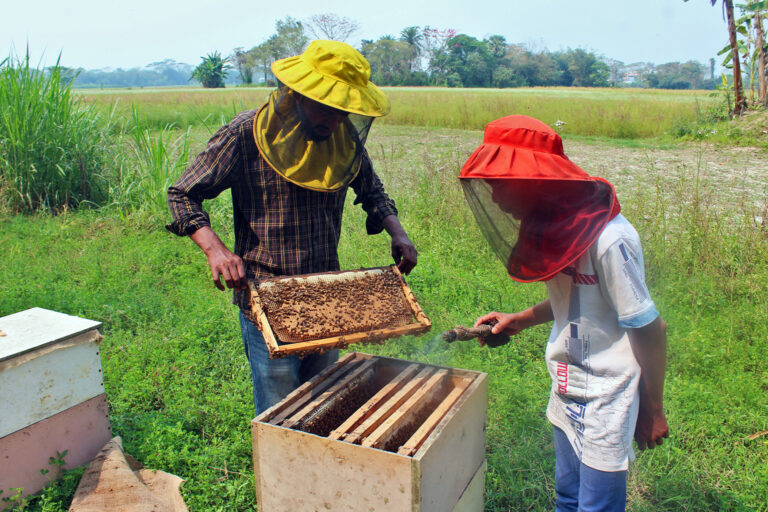
Heavy rainfall in Colombia and Venezuela caused deadly landslides and widespread flooding in June. A new analysis now points to rapid urbanization, deforestation, mining and overgrazing as having reduced the region’s climate resilience.
“The rapid growth of population and informal settlements in areas prone to landslides, particularly in Colombia, puts people and infrastructure at risk,” the World Weather Attribution (WWA), a network of scientists evaluating extreme weather events, said in its latest rapid analysis. It said the informal communities are growing as people seek livelihoods in cities or are displaced due to conflict.
Roop Singh, report co-author from the Netherlands-based Red Cross Red Crescent Climate Centre, said at a media briefing that pasture- and agriculture-driven deforestation rose over the past two decades, increasing “the risk of landslides because tree roots are no longer binding and anchoring the soils.”
The heavy rains during the last week of June triggered widespread flooding and damage in Colombia; a landslide in Antioquia department killed 27 people. In Venezuela, rivers overflowed, and smaller landslides cut off rural communities.
WWA said in its report that rains in these regions had persisted since April, and that the June rain fell on already saturated ground where the deadly landslide occurred, and in rivers with already high levels of water.
The scientists examined the total rainfall from April-June this year over the Magdalena River catchment in Colombia and the Falcón and Maracaibo basins in Venezuela. They also studied data on the accumulated rainfall from June 20-24 in the affected states in the Venezuelan Llanos, a grassland plain.
“Neither events were particularly extreme,” Mariam Zachariah, co-author and research associate at Imperial College London, said at the briefing.
The WWA analysis showed the heavy rain that fell in June is common, expected every 10 years in Colombia and every three years in Venezuela. The scientists also used climate models to understand the influence of human-induced climate change on the rains, but the findings were inconclusive. Instead, the models projected a drying trend for Colombia and mixed results for Venezuela.
Friederike Otto, co-author and climate science professor at Imperial College London, said not being able to show clear linkages to climate change doesn’t mean there’s no influence. The researchers attributed some of the uncertainty to a lack of long-term observational weather data and weather stations in the region.
“Unfortunately, extreme weather is not well understood in northern South America,” Paola A. Arias, a professor at the University of Antioquia, said in a statement. “We urgently need more investment in climate science to understand shifting risks and prepare for what’s ahead. More science will save lives.”
Zachariah said Colombia and Venezuela must prepare for both rainfall and drought, and build resilience to extreme weather.
Banner image: People look at their destroyed home after a deadly landslide was triggered by heavy rain in Colombia’s Antioquia department on June 25, 2025. Image by AP Photo/Fredy Amariles.
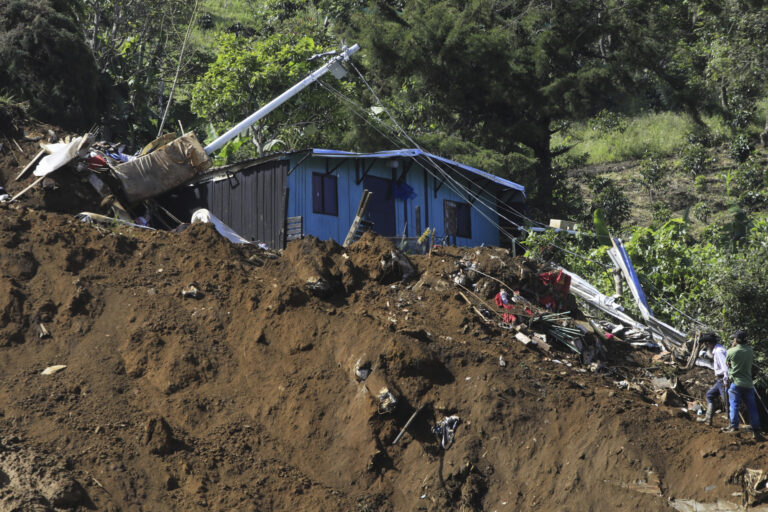
NEW ORLEANS (AP) — Louisiana is officially canceling a $3 billion coastal restoration project funded by the Deepwater Horizon oil spill settlement. The Mid-Barataria Sediment Diversion Project aimed to rebuild over 20 square miles of land in southeast Louisiana to combat erosion and sea level rise. Conservation groups supported the project as a science-based solution to climate change. However, Republican Gov. Jeff Landry opposed it, citing harm to local oystermen and the fishing industry. On Thursday, a coalition of federal agencies overseeing the settlement funds declared the project “no longer viable” because of litigation and a suspended federal permit after the state halted work.
Read the full story by Jack Brook, Associated Press/Report for America
Banner image: The nearly $3 billion Mid-Barataria Sediment Diversion project along the Mississippi River, intended to stave off coastal land loss in southeastern Louisiana, is seen during a flyover with the environmental coalition group Restore the Mississippi River Delta, Aug. 29, 2024. (AP Photo/Jack Brook, File).

Founder’s Briefs: An occasional series where Mongabay founder Rhett Ayers Butler shares analysis, perspectives and story summaries.
In a nation where speaking up can lead to prison, a group of young Cambodians has refused to be silent. One year ago, five members of Mother Nature Cambodia, a conservation NGO, were jailed on charges of plotting against the government. Their real offense, it seems, was speaking out — against the privatization of national parks, the eviction of families to build airports and casinos, and the environmental cost of large-scale conversion of nature.
The Clearing, a documentary chronicling their final months of freedom, offers a sobering portrait of activism under authoritarianism. Ly Chandaravuth, among the most outspoken of the activists, is seen calmly filming the stumps of vanished trees and asking villagers about land lost to corporate concessions.
“Eighty percent of the park has been handed to private companies,” one local explains. There are no histrionics, only quiet defiance.
The group’s impact has been real. It has helped halt sand exports and dam construction. But the cost is steep: 11 members jailed, many more arrested, and its founder in exile. A courtroom summons looms over nearly every scene.
And yet, the group endures. Last year, it received the Right Livelihood Award in Stockholm, often dubbed the “Alternative Nobel.” Barred from travel, several activists stayed behind. Those who attended wore borrowed coats, shivered through interviews, and made clear they would return to face trial.
The day after the award ceremony, the summons came.
“In the best case,” one activist said, “we’ll return to our country safely. In the worst case, we’ll become more famous because they arrest us at the airport.”
Such gallows humor masks real fear, but not retreat.
“This award isn’t only for us. It’s for everyone,” they tell supporters.
In a country where peace has too often meant silence, they have chosen to speak — and in doing so, have made themselves heard far beyond Cambodia’s borders.
Watch the documentary The Clearing here.
Banner image: Ly Chandaravuth, Mother Nature Cambodia activist. Image © Andy Ball.

Researchers describe the kultarr as “Australia’s cutest mammal”: It’s eyes are quite large for its mouse-like head, it’s ears are perky and it has long, thin legs that allow it to run so fast that it looks like it’s hopping. A recent study has now confirmed that the insect-eating marsupial is not one, but three distinct species.
Previously, scientists considered Antechinomys laniger — referring only to the kultarr — as the sole species under the genus Antechinomys.
But in 2023, a genetic study reclassified another marsupial, the long-tailed dunnart (previously Sminthopsis longicaudata), as a second species under Antechinomys (A. longicaudatus). The study also showed genetic differences between some kultarr specimens.
Building on that study, researchers examined kultarr specimens collected in museums in Adelaide, Brisbane, Darwin, Melbourne, Sydney and Perth over the past century. Genetic analysis of the tissue samples along with the specimens’ body measurements confirmed that the kultarr, A. laniger, was actually three separate species.
“The three species of kultarr live in different regions of Australia and have different habitat preferences,” Cameron Dodd, study’s lead author from the University of Western Australia, told Mongabay by email. “Identifying them as different species will allow for more targeted conservation approaches that best suit the unique biology of each species, rather than a ‘one-size-fits-all’ approach which might not be optimal for any of the species.”
The eastern kultarr (A. laniger) is the smallest of the three species, with an average body length around 7.5 centimeters (3 inches). It is darker, has smaller ears and a less elongated snout as well. The eastern kultarr is found in parts of central New South Wales and southern Queensland.
The gibber kultarr (A. spenceri) is the largest and stockiest among the three, with an average body length of 9 cm (3.5 in). It has a bigger head and thicker, longer legs than the others. It inhabits the stony deserts of the “gibber plains” in southwest Queensland and northeast South Australia.
The long-eared kultarr (A. auritus) is sized between the other two but has the largest ear-to-head ratio of all kultarrs. It lives in the sandy deserts of central and western Australia.
The conservation status of the kultarr was last assessed in 2014, and it remains listed as least concern, although it is considered endangered in New South Wales. The authors write that with the taxonomic revision, all three species need new assessments.
Dodd said kultarrs, dunnarts and other marsupials are crucial for controlling insects after rains, “preventing both native vegetation and crops from being decimated by plague-like insect numbers.” The marsupials are also important food for birds and snakes.
He added the loss of these insectivores would severely degrade ecosystems already damaged by the decline of Australia’s fauna due to habitat clearing, hunting and the introduction of invasive cats and foxes that accompanied European settlement.
Banner image: (L-R) the eastern kultarr (image by Pat Woolley), the gibber kultarr and the long-eared kultarr (images by Ken Johnson).
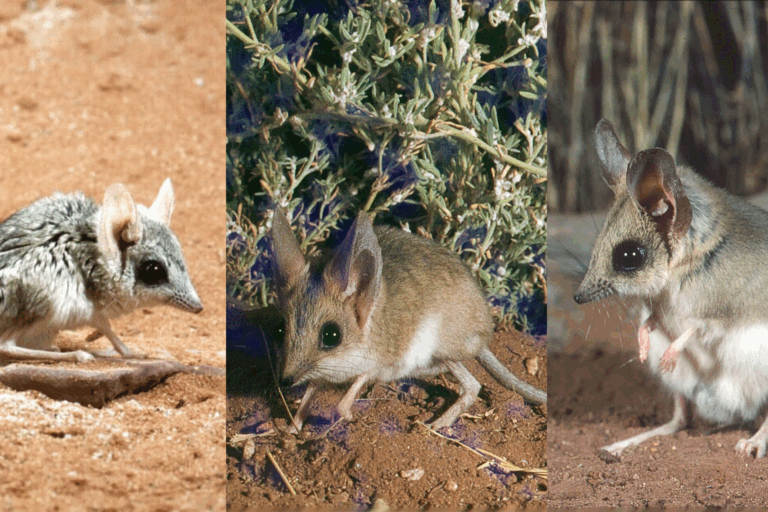
GENEVA (AP) — Soccer faces growing challenges from extreme heat, as seen during the FIFA Club World Cup in the U.S. this summer. Rising global temperatures are making summer tournaments increasingly dangerous for players and fans. Scientists warn that continuing to hold events in June and July could lead to severe heat-related illnesses. FIFA introduced measures like extra water breaks and shaded benches but still faced criticism from players. Experts suggest shifting tournaments to cooler months, though this disrupts traditional soccer calendars. With the 2026 and 2030 World Cups scheduled in hot regions, addressing heat risks is becoming urgent as climate change worsens.
Read the full story by Graham Dunbar and Seth Borenstein, Associated Press, here.
Banner image: Palmeiras’ Vitor Roque sits on the side of the pitch in a cooling mist after being substituted during the Club World Cup round of 16 soccer match between Palmeiras and Botafogo in Philadelphia, Sunday, June 29, 2025. (AP Photo/Matt Slocum, File)

you're currently offline



